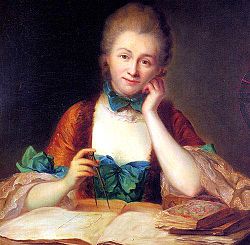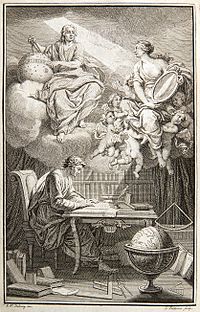by Maurice Quentin de La Tour


 |
T
hus it was, at the age of thirty-nine, that Voltraire started his famous sixteen-year liaison with Mme du Châtelet. She was twenty-seven, married, and the mother of three children. She had already had a number of lovers which was the custom of the time for someone of her status. She was a uniquely accomplished woman, and it was the combination of her intellectual talents and her vivacious personality that drew Voltaire to her. As he wrote in his memoirs,"I found, in 1733, a young woman who thought as I did and who decided to spend several years in the country, cultivating her mind."
As a girl, Émilie de Breteuil lived with her family overlooking the Tuileries gardens in Paris, in an apartment with 30 rooms and 17 servants. But although her brothers and sisters turned out as might be expected, Émilie was different, as her father wrote:
"My youngest flaunts her mind, and frightens away the suitors."
She had an unusual education for a girl at the time - in addition to the academic lessons in mathematics, science, languages and philosophy provided by private tutors, she was also given lessons in fencing, riding, and gymnastics. By the age of twelve she could read, write, and speak fluent German, Latin, and Greek. In spite of her talents in the area of languages, her true love was mathematics, and all her life she continued to study with the leading mathemetical tutors of Europe.
 |
É
milie's father introduced her to the court at Versailles when she was sixteen. Émilie was delighted with the splendor and extravagance of court life, and developed a taste for all things expensive. At age nineteen, Émilie married the marquis du Châtelet. She had three children with him after which she was considered free to have have affairs with other men. In 1733, she began her affair with Voltaire, a partnership which lasted the rest of her life, and they lived together as a couple (with the approval of her husband) in her château at Cirey-sur-Blaise. Together they lived a life of scholarship and discovery, centering on their studies of the natural sciences, philosophy (in particular metaphysics), history, literature and religion. They collaborated on Voltaire's publication Elements of Newton and Emilie embarked on what was to become her magnum opus, the annotated translation from the original Latin into French of Newton's Principa. The best-known accounts of their Cirey life - those of Madame de Grafigny which date from the winter of 1738-39 - depict Émilie and Voltaire's frequent arguments and reconciliations (Voltaire taught Émilie English so that they could argue in front of the servants).Whereas there is no doubt that for many years they had a passionate physical relationship, by 1746 Voltaire had discontinued their sexual relationship (giving the excuse that he was too old and keeping from Émilie the real reason - the fact that he had fallen in love with his widowed niece, Marie-Louise Denis) but their friendship and intellectual collaboration continued to the end of her life.
I
n 1748 Émilie fell passionately in love with the courtier and poet Jean François, marquis de Saint-Lambert while staying at the estate in Lunéville of the exiled Polish king Stanislasus. Although at first he returned her affections, and was flattered and intregued by the attentions of this distinguished older woman; eventually her uncompromising and possesive infatuation caused his ardour to cool. In December of 1748, Émilie returned to Circey, where to her horror she discovered she was pregnant with Saint-Lambert's child. This was a potential disaster for Émilie, with consequences both for her health and her reputation. Voltaire and Émilie conspired to convince her husband the marquis that the child was his staging an elaborate seduction scene, and a very short time later the marquis was informed that Émilie was pregnant with his child. Feeling increasingly anxious about the pregnancy, Émilie worked feverishly to finish her great translation of Newton before she gave birth. As Voltaire wrote in the preface to Émilie's translation of Newton's Principia:"She had not finished writing her explanations when she foresaw that death would carry her off.... From that time on, her one thought was to make use of the little time she had left to finish what she had started and to deprive death of what she regarded as the best part of herself."
She finally finished and six days later, on the night of 3 September 1749, she gave birth to a daughter, Stanislas-Adélaïde. At first, all appeared to go well, but a week later she developed an infection and died on 10 September 1749 at the age of 43. Voltaire was beside himself:"I have not lost a mistress, I have lost half of myself, a soul for whom my own was made,a friend of 20 years whom I had seen born."
A few days after her death, he wrote the following lines and pinned them to the portrait of the woman who had been - and would remain - the love of his life.
L'univers a perdu la sublime Émilie
Elle aima les plaisirs, les arts, la vèritè.
Les dieux, en lui donnant leur âme et leur gènie,
N'avaient gardè pour eux que l'immortalitè.
(The universe has lost the sublime Émilie!
She loved pleasure, art, and truth.
The gods gave her genius and their soul,
Everything they had - save immortality.)
É
milie's translation and algebraic commentary on the Principia remains her outstanding acheivement and best-known book. The work, to which Voltaire added a historical preface, was finally published in 1759, ten years after Emilie's death. It was reprinted in 1966, and remains the only French translation of the Principia - and is still in use today.
Deirdre Moore  195B Rue du Velard
195B Rue du Velard  Thoiry, 01710
Thoiry, 01710
Contact the webmaster at:
deirdremarymoore@hotmail.com